The thing about the proposed Asylum Avenue changes is that the plan is all over the place. Was the lead on this project a Gemini, because if so, I get it. You want to use every crayon in the box. But there’s a time and place for that, and it’s not when people’s lives are at stake. I’d even get it if the number of existing car lanes changed every block, but that’s not even close to being the case. I’m working my ass off to give the benefit of the doubt here.
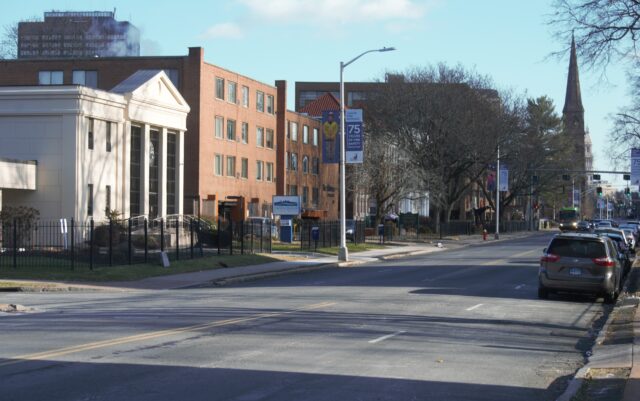
To show what I mean, let’s take a stroll through the plans (dated 4 November 2022) covering 1.4 miles, going section-by-section from the West Hartford line, east to Sumner Street. Shall we?

This first section — bordering a park, governor’s mansion, wealthy residential area — has what appears to be a paint-only bike lane eastbound, with sharrows westbound. Bro, do you even bike? If you absolutely need to sprinkle sharrows on one side of the road (you don’t!) you do that on the one where someone is riding downhill. . . not when they are struggling uphill. We can learn from West Hartford’s screw ups with their part of Asylum Avenue and what they did near Elizabeth Park. Nobody wants impatient and/or angry motorists behind them while riding slowly up a hill.
What we should have are “climbing bike lanes.”
I wonder about why it looks like they are choosing between sharrows and bike lanes at all. There is possibly space for bike lanes on both sides of the road, if only they removed the special turn lane. If drivers get a lane in both directions, why shouldn’t cyclists?

That pattern continues for a bit, but then we see the introduction of flex posts protecting the bike lane, which is now on both sides of the road. Good. Great. This is what the entire project should look like. No need to mix it up. This is it.
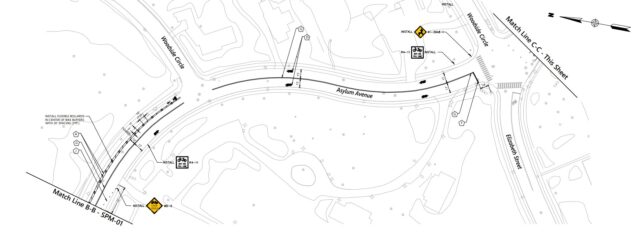
Except, hold on, why would we keep the safest option? The barriers are removed at the curvy part of the road. . . exactly a place where we want the street to be narrower to discourage motorists from taking the turn too quickly. Not only do we lose the flex posts, we lose the bike lanes and are slapped across the face with sharrows.
Do you know what they can do with their sharrows?
That.
They can also save money on paint and labor, not use sharrows, and spend those savings on something else. Maybe a few extra flex posts, or fill a couple of them with concrete. I have many ideas. But if your choice is to sharrow or not to sharrow, just don’t. Nobody except insiders and hardcore cyclists know what the hell they even are.
While the road appears narrower in general around the curves, the car travel lanes still seem wider than necessary. I’m sure someone will get in the comments with the regulated road width blah blah blah, but these are all human-created rules and we can change them. Is it wide enough to safely accommodate both bike lanes and buses? Then keep the bike lanes.
It’s unclear to me if redoing sidewalks is within the scope of this project, but that would be my alternative suggestion: if they won’t provide barrier-protected bicycle lanes, then install wider sidewalks so cyclists have a better place to go. A lot of the sidewalk along Asylum Avenue should be redone anyway as it’s abundant with tripping hazards. By the way, I am writing this as someone who has jumped onto the sidewalks while cycling up Asylum Avenue toward Elizabeth Park, rather than ride on the street, the the sidewalk is choppy in some places and narrow in others, which is very awkward when struggling up the hill and then having to stop because there is not room for both you and the person walking their dog just ahead. What I’m saying is that it’s always important for designers to talk to those who use the space they’re altering.

The flex posts protecting bike lanes on both sides returns for the section of Asylum Avenue between Elizabeth Street and Woodland Street — and that’s a damn good thing because this is where Classical Magnet is located. I’m unimpressed that no mid-block crosswalk was added. People want to cross from parking lots on the south side of the road to get to the school, and this is a long block as is. Ideally, these folks would just take the bus, but either way, there should be a safer way to get across Asylum Avenue. Don’t know what I’m talking about? Stand down there in the 8:30-8:45 block on a weekday morning and cringe while students and teachers attempt to cross Asylum Avenue.
I know what the pushback will be, and I have yet to be convinced that someone’s desire to speed in and out of Hartford is more important than the safety of those moving on foot or bicycle. Those who don’t like congestion can pick a form of transportation that contributes to it less.
Some folks like to talk about needing to be “balanced” when making such changes, but they’re not talking about balancing one mode’s convenience with that of another or balancing safety with safety. It’s always “what level of safety can we provide pedestrians and cyclists before it becomes inconvenient for motorists.”
Who wants to be brave enough to say let people be mad about being stuck in a traffic jam of their own creation if it means all road users are safer?
With anything, you have to think about how the parts work together and where the big problem areas are. The intersection of Asylum and Woodland is a nightmare. Too many lanes in all directions. It’s so. . . wide open. Drivers blow through the intersection — especially driving south on Woodland Street — at high speeds, and several ignore the red light at almost every cycle. This continues to be the case even after the redesign that happened there last year.
The image below is taken from the Connecticut Crash Data Repository, looking at where any type of vehicular crash occurred where the result was property damage and/or bodily harm.
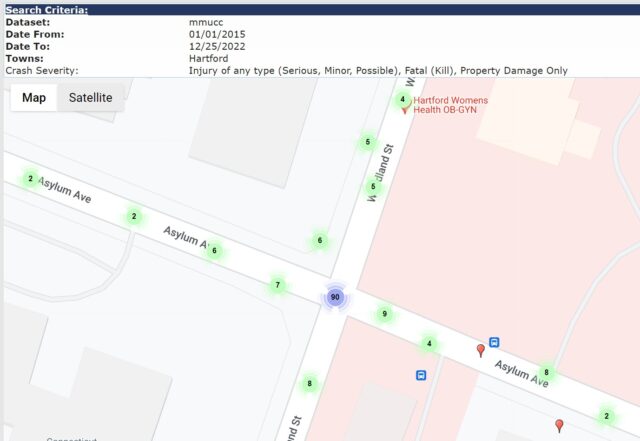
For another perspective, here is a look at more of the project area, but showing only crashes resulting in physical harm, including death:
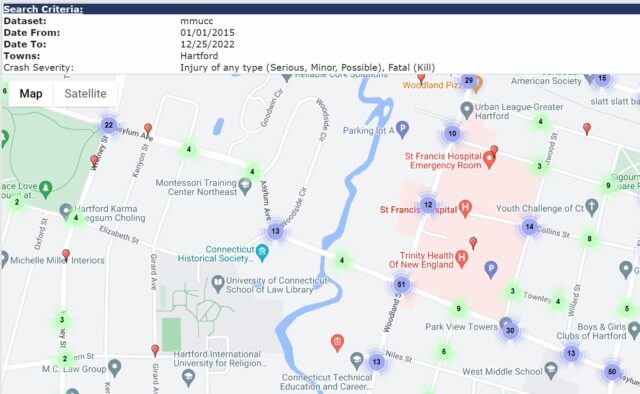
What I looked for in the plan was what changes were in store for this and other frequently problematic intersections. I’m still looking.
There are fewer car travel lanes, it appears, but I wondered why there weren’t raised crosswalks. There are always people waiting to cross. It’s near a hospital and other medical offices. Near a school. There are bus stops. Yet if you try to cross, you have to be ready to jump out of the way of someone driving through at 50 MPH. Is that what we should be asking anyone to do, especially those going to/from medical appointments?

The next segment of Asylum Avenue most notably has hospital driveways and the annoyance of Gillett Street, which should really be one-way on this end. Go and cross it a couple times a day and you will see what I mean. Drivers are especially reckless turning onto or out of it, not looking to yield to pedestrians, and having conflict in one less direction would be an improvement. If not limiting direction of travel, could we at least get curb extensions and a marked crosswalk?
What’s that? This is the Asylum Avenue project and not Gillett Street project? Well, as part of this, Atwood Street is possibly being changed from two-directional to a one-way with lots of street parking added. I will applaud that, and ask for more. (Pic below is of Atwood Street looking toward Asylum Avenue)
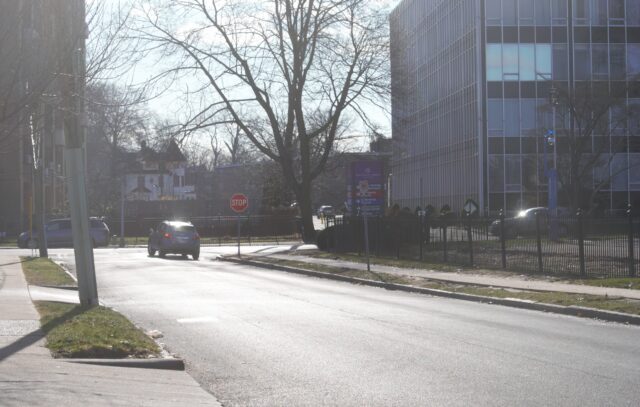
But, let’s see what the plans show us.
We have paint-only bike lanes. Problem identified. Currently, people park on the south side of the street and without flex posts, that will likely continue to be the case, even with the changes on Atwood Street. Additionally, have you observed how hospital employees drive? You might expect them to be more cautious given their vocation, but that’s sadly not the case. Protected bike lanes are needed here.
More than that, this would be a place to have a bus-only lane. Hell, there should be a bus-only lane on Asylum from Main Street to at least Woodland Street. As a reminder, because I won’t let it go, there was a push for bus lanes years ago, but a fancy schmancy downtown restaurant’s owner complained because it would, in his opinion, impact the restaurant’s valet parking. We have different leadership now, and maybe someone will let the dude know that this is not the way.
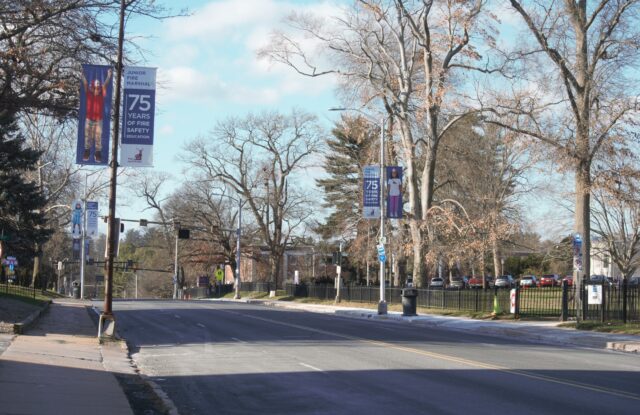
Why bus lanes?
Go wait for the bus to West Hartford by St. Francis during one of their shift changes. You can see your bus down the block with only a few vehicles ahead. It should make it to you in about thirty seconds. But, more and more people drive out of the hospital parking lot, and now the wait is closer to five minutes, or more. Try this when it’s 15ºF outside or when you are on a schedule. Or when there’s a squad of people doing leaf blowing on the hospital grounds and you’re standing there wondering how much hearing damage this is causing you.

What is even happening here?!
There are sharrows on one side, and then a shared bus/bike lane.
We get a bus-only lane for . . . one block? Why?!
My understanding of a bus-only lane is that it exists to speed up public transportation. It’s like the HOV lane for urban areas. Those making a wiser transportation choice get priority and are not held up in the congestion created by single-occupancy vehicles.
Why are they using it more as a loading zone? Where do cyclists go when buses are here loading people for extended periods? Will it be wide enough for cyclists to go around?
I’ll say it again: we could have a bus-only lane from Main Street to at least Woodland Street, maybe even down to Classical Magnet, if we wanted it. By the way, that bus-only lane could also be used for moving emergency vehicles more quickly.
And for reasons I don’t understand, now there is no bike lane, only sharrows.
I’ll keep saying it.
Cyclists should be able to have predictable lanes. If drivers need to turn, they can wait. Or, take the bus and move faster in a bus lane.
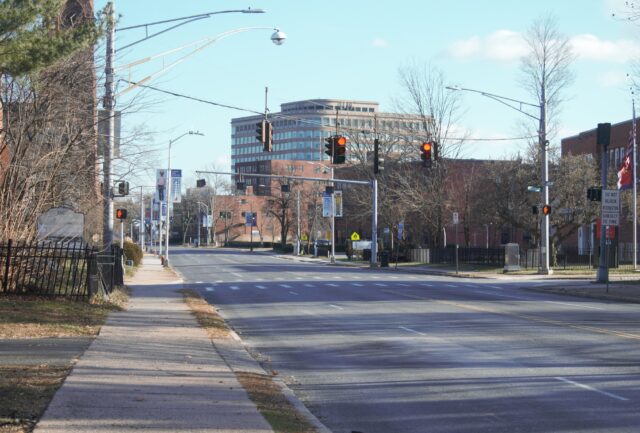
Sigourney and Asylum is another bonkers intersection. There used to be three crossing guards stationed at this one, and still motorists would blow throw while kids were in the crosswalk while the pedestrian-crossing light was on.
The Connecticut Crash Data Repository Map shows the Sigourney and Asylum intersection — see the yellow dot — as officially being a hot mess. Personally, my solution would be to entirely close intersection except to people walking and cycling because how do you justify this staying open? Quick math: that’s about 16 crashes per year in that intersection, without counting those nearby that are spillover from it.
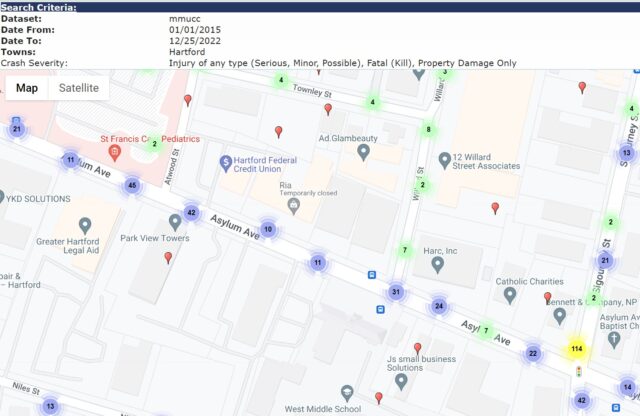
Back to this in a moment.
East of the intersection, the plan includes flex posts guarding the bike lane, which has returned, on both sides of the street. While walking outside of rush hour, I witness people driving at obscene speeds on this stretch. Particularly alarming are those taking their vanity trucks down here at speeds unsuitable for urban areas. They do this because there is so much space telling them to go for it. This is how people get killed. Installing bike lanes surrounded by flex posts will help with everyone’s safety, but I can’t help but look at the center turn lane and wonder why not a bus lane. There are not so many people turning onto Huntington Street that vehicles behind them can’t wait a few seconds.
I want us all to be more willing to tell drivers to patiently wait their turn, and of course, design for it.
The traffic calming created by the addition of bike lanes will improve the intersection with Sigourney Street.
I still want more. This is another place where there could be raised crosswalks. There is a school on one corner, and is where people cross who are going to the other nearby school on Niles Street.
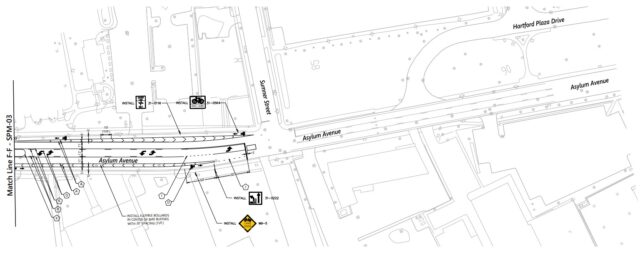
You have made it to the last section of this project.
The flex post-protected bike lanes end at Sumner Street, which is the end of the project. . . and a reminder that no real thought goes into the mobility of those outside of vehicles. I fantasize about constructing massive barriers, like walls of snow, across the travel lanes that drivers use, just whenever I feel like it. And then when they complain, I can point out how grateful they should be that they were able to drive for five or six blocks in this direction before their path was abruptly ended.
It’s not like Asylum Avenue is any safer here. You might ask how you are expected to bike, safely, downtown at this point.
I would focus on that less if what happened within the scope of the project was consistently gold standard. It’s not. So it’s hard to say that in good faith those tasked with creating these plans would follow up by someday extending this project area to fix the rest of Asylum Avenue, and then redo the parts of Asylum Street in downtown that were meekly adjusted relatively recently.
There’s the problem: meekness.
We see it in other projects in Hartford. We see it outside of Hartford. The closest we have to functional infrastructure is the section of Wethersfield Avenue where there are massive planters in the middle of the road and flex posts separating the bike lane on one side. This works beautifully where the posts are, but does not continue into downtown, nor does it begin until after an elementary school. We saw lots of money dumped into Albany Avenue, which is not worse now, but not nearly at the level one would expect for that investment. Moving vehicles quickly still appears to be the priority, even though we have I-91 and I-84 for that purpose. Portions of Farmington Avenue are improved, with medians narrowing the road and slowing drivers down, but the paint-only bike lanes are more symbolic than functional and pedestrian crossings feel so haphazard.
When a street has four lanes, I see this as the potential for conversion to two barrier-protected bike lanes while keeping two car travel lanes. If the car lane doesn’t disappear and reappear every block, why should that be what cyclists experience? Equity, safety. . . these are not things that should be considered only when most convenient.
The photographs in this post were taken on a Sunday holiday, intentionally. The long-time standard when building parking lots has been to make sure they would accommodate shoppers on the busiest days of the year. Then, when it is not Black Friday or mid-December through Christmas, the lot is an obvious waste of space. Asylum Avenue, outside of weekday morning and evening rush hour, is only slightly busier than what you see in these photos from Christmas. This means that those driving on the weekend or a weekday afternoon can easily barrel down the street, and as we all should know by now, higher speeds mean a greater chance of death for anyone hit by those vehicles.
The changes we have seen to Hartford’s streets the last few years have been overdue, and I understand how seeing any change after so many years of garbage can make some dish out heaping amounts of praise, but I’m going to urge safer streets advocates to always ask for more. What is your life worth? Ask for it. Ultimately, it’s possible that there really isn’t space for bus-only lanes on half the project area, or room for barrier-protected bike lanes for all of it, but what good reason is there to not ask leadership to try harder to make this happen? Maybe that can be the New Year’s resolution: stop settling for less than we deserve; ask the government to do more so all of our most basic needs are met.
An additional public information meeting, date not yet announced, is planned for January. Visit that website to find out how to give feedback.
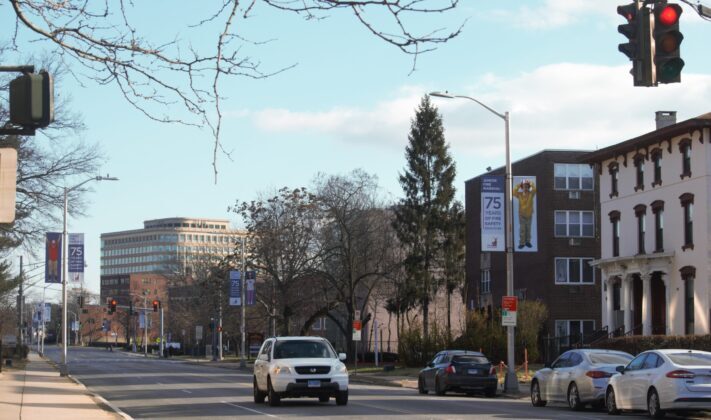
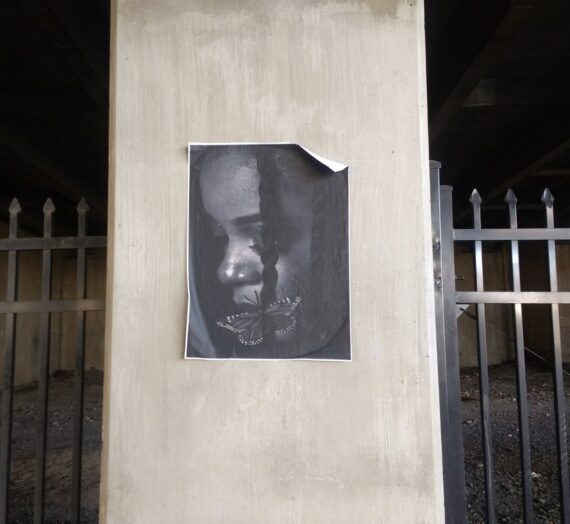
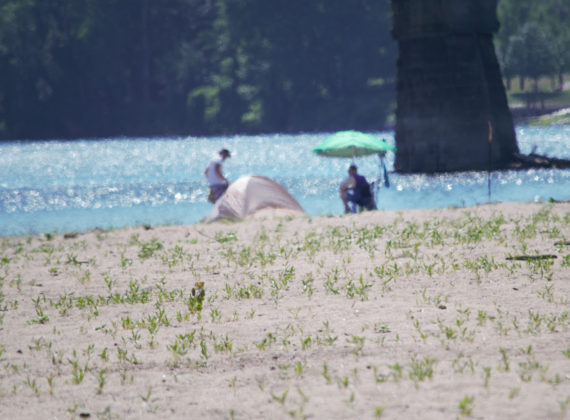
Linda Pagani
Thank you for your diligence in reporting on this. I’m in fear for my life on the entire stretch from Asylum at Sisson all the way to downtown. It is a traffic free-for-all race track. The Woodland to Sigourney stretch is pure anarchy, especially at Atwood St. Also, to add further indiginity to the bus riders at the St. Francis stop on Asylum heading toward West Hartford, there is no shelter, and therefore no protection from the elements, or from speeding drivers who splash collected rain water and slush from the curb all over the sidewalk and those who are on it. (I know this isn’t confined to this area, but that’s what we’re talking about here.) Finally, how is this proposal even compliant with Complete Streets plans for West Hartford and Hartford?
Linda Pagani
*I meant Asylum Ave. @ Whitney Street